Managing Wildlife Populations
Golden Eagle Survey: Wildlife Biologists Prince and Turnock checked on two historic golden eagle territories and one potential new territory. A single historic territory had an adult eagle sitting on a nest and likely incubating eggs or newly hatched chicks.

Bats: Biologists Lowe and Brinkman captured bats to collect samples to test for presence of the fungus responsible for white-nosed syndrome, a disease linked to large bat die-offs throughout the United States. The capture was conducted at a maternity colony of Yuma myotis (Myotis yumanensis) in Whitman County with assistance from WDFW Private Lands Technician Nizer, two biologists with Bureau of Land Management (BLM), and a professor from Eastern Washington University with three of his students.


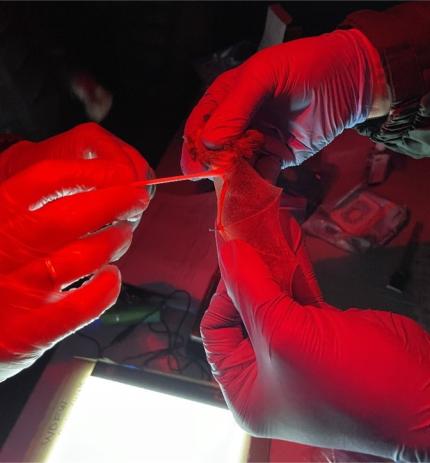
W.T. Wooten Wildlife Area Elk Fence: Wooten Wildlife Area personnel checked the elk fence from Mountain Road to the Wooten Headquarters. Wildlife Area Manager Dingman found a large hole in the fence that required Natural Resource Worker Jensen and Natural Resource Technician Tritt to return the following day with supplies to repair it.


Providing Recreation Opportunities
Terminally Ill Hunter: Wildlife Conflict Specialist Kolb worked with an out-of-state hunter granted a terminally ill elk permit for later this summer. Kolb will try to ensure the hunter has property to hunt due to the game management unit (GMU) permitted being almost entirely private property.
Landowner Contact: Natural Resource Technician Janowski spoke with a landowner enrolled in Hunting Only by Written Permission regarding the spring turkey season and parking. The landowner received concerns from their neighbors regarding so many vehicles parked on the property and wanted a way to know if somebody is a hunter or not. Janowski informed the landowner to give hunters an extra blue slip with a cut notch to slide in the window visor to indicate to neighbors of who is a hunter or not. The landowner liked this idea and will implement this going forward.
Turkey Hunters: Private Lands Supervisor Earl discussed hunting opportunities with several people this week. One individual was out here from back East. He is trying to be the youngest person to complete the U. S. Super Slam. Earl was able to get him on some birds and he harvested a nice tom. His 44th state harvest. The following day he traveled into Oregon and harvested an Oregon tom which was #45 for his super slam. Earl also received a call from a successful hunter that harvested her first ever tom on a newly planted food plot that Earl seeded last year.
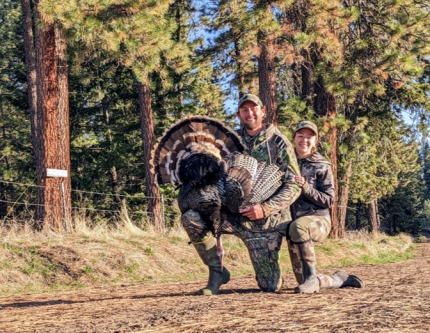

Mississippi Turkey Hunter: Wildlife Conflict Specialist Wade assisted a hunter who traveled from Mississippi to Washington to hunt turkeys. Wade as well as other WDFW staff assisted the hunter with finding locations to hunt. Wade followed up with the hunter who reported that he was able to fill both of his Washington turkey tags. The hunter was very thankful for the assistance from Wade and other WDFW staff members.

Providing Conflict Prevention and Education
Pend Oreille County Library Grizzly Bear Aware Events: Wildlife Biologist Turnock presented at a bear aware event hosted by the Pend Oreille County libraries that was coordinated by the Kalispel Tribe. The event taught participants about bear biology, how to tell the difference between grizzly and black bears, how to avoid negative interactions with bears, and how to use bear spray. There was a hands-on bear spray training taught by a U. S. Fish and Wildlife Service grizzly bear specialist and every participant went home with a free can of real bear spray at the end of the day. The events totaled over 50 participants and was put on in collaboration with the Kalispel Tribe, Defenders of Wildlife, WDFW, and the U. S. Fish and Wildlife Service.

Asotin County Wolf Activity: Wildlife Conflict Specialist Wade continued to have check-ins with the Asotin County Cattleman’s Association president and multiple producers in the area of recent wolf activity. Wade traveled to the Anatone area to look at a cow that had died after falling off a bluff. Wade and the producer determined that the carcass could not be removed from the site. Wade provided the producer with lime to put on the carcass, which should discourage scavenging. While in the area, Wade checked the area of continued wolf activity near Anatone. Wade also worked with a producer to get access to their property so Wolf Biologist Spence could survey an area of dense wolf activity.
Bear Damage: Natural Resource Technician Harris followed up on a report of a black bear repeatedly getting into garbage. Harris received a phone call from a landowner in Stevens County that had a black bear get into her porch freezer. Harris deployed a game camera and electric fence around the porch.
Conserving Natural Landscapes
20th Annual Rocky Mountain Elk Foundation Work Party: Volunteers from the Rocky Mountain Elk Foundation gathered at Smoothing Iron Ridge on the Asotin Creek Wildlife Area for the 20th annual work party this weekend. There were 35 volunteers working on Friday, Saturday, and Sunday. Many traveled from Western Washington to participate. Even though the weather was wet, and mud prevailed, they were able tear out quite a bit of barbed wire fence destroyed during the 2021 Lick Creek Fire. They also removed hog wire from two burned enclosures used during pilot grazing 15 years ago. Additionally, several water troughs and springs were cleaned, one water trough was replaced, and salt blocks were placed at various locations for elk and deer. Assistant Wildlife Area Manager Woodall coordinated work activities this year. Also attending from WDFW was Wildlife Area Manager Dice and Natural Resource Technician Rimmelspacher.

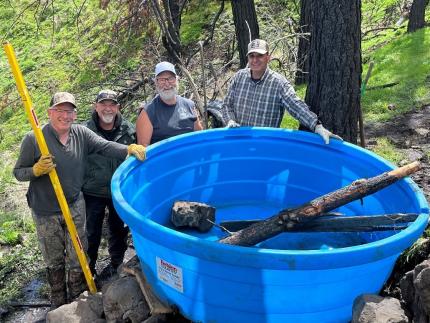


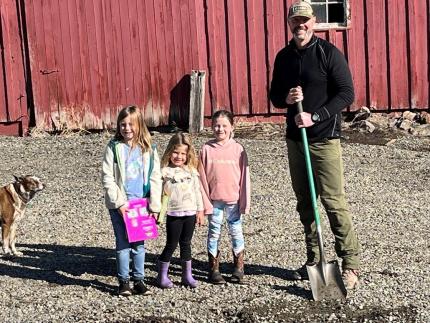
Tree Planting: Natural Resource Technician Janowski picked up 1,500 conifer trees for a planting project on a Hunting Only by Written Permission property. Janowski, Harris, Conflict Specialist Samsill, Inland Northwest Wildlife Council, and the Stevens County Conservation District all were able to plant 1,100 trees this week. Janowski will plant the remaining 400 trees early next week.
Wildlife Food Plots: Private Lands Biologist Gaston, Natural Resources Technician Nizer, and Natural Resources Technician Rumiser all finished installing wildlife food plots on private lands enrolled in the WDFW public access programs. Food plots were varied with some including alfalfa and clover, while others were more of an annual food plot mix.
Turkey Habitat Project: Private Lands Biologist Gaston and Natural Resources Technician Nizer worked with volunteers to finish planting trees on a project funded for turkey habitat restoration. The area is on private property enrolled in the WDFW Private Lands Access Program in the area recovering from the 2020 Babb-Malden fire.
Invasive Grass Species Test Plots: This week private contractor and former Bureau of Land Management employee Lorna Emerich and her husband Jim Emerich came out to start the pre-herbicide application data collection for the three invasive grass test plots that are already in place and measured out. Lorna is collecting the plant identification of species in each of the plots where five different herbicides will be tested. Lorna will be back in mid-July to repeat the data collection post application. Wildlife Area Manager Finch took photos on the ground and by using the drone for documentation.
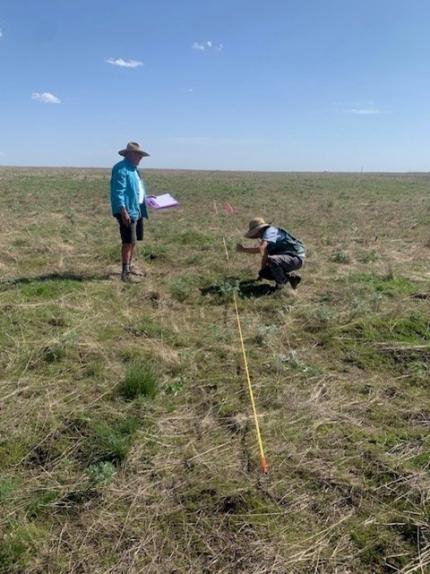
Hartsock Garbage Dump: Natural Resource Technician Tritt and Natural Resource Worker Jensen cleaned up approximately 40 tires that had been dumped in the ditch along Hartsock Grade. Access Tech Heimgartner hauled the tires to the Asotin County landfill for disposal.



4-O Ranch Grass Seeding Project: Wildlife area staff members moved our seed drill from Smoothing Iron to the Bucannon Field on the 4-O Ranch Wildlife Area on Wednesday. Wildlife Area Manager Dice moved a John Deere tractor from Joseph Creek to the 4-O to pull the drill. Dice began seeding on Friday and ran out of seed late Saturday afternoon with about six acres left to go in the 53-acre field. We are planting the field to orchard grass as a lure crop to hold elk on the wildlife area.
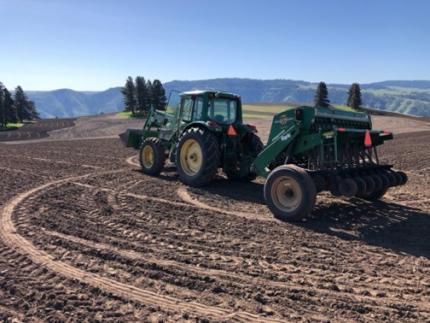
Smoothing Iron Ridge Spraying: Natural Resources Technician Meisner moved our 50-foot sprayer from the 4-O Ranch to Smoothing Iron Ridge on Wednesday. On Thursday, wildlife area staff set up the sprayer behind our Case 4490 tractor and began spraying glyphosate herbicide on fallow fields. We also set up a 30-foot boom sprayer on our 6130R tractor to begin spraying winter wheat fields for broadleaf weeds. There’s a lot more spraying to complete next week.


Conservation Reserve Enhancement Program Rehabilitation: Private Lands Biologist Gaston, Natural Resources Technician Nizer, and Natural Resources Technician Rumiser worked as a team to rototill, harrow, mow, and seed a small Conservation Reserve Enhancement Program project outside of St. John to assist the Rock Lake Conservation District. Rock Lake Conservation District Manager Harrold assisted with seeding and tree planting at the site and the project was completed in two days.
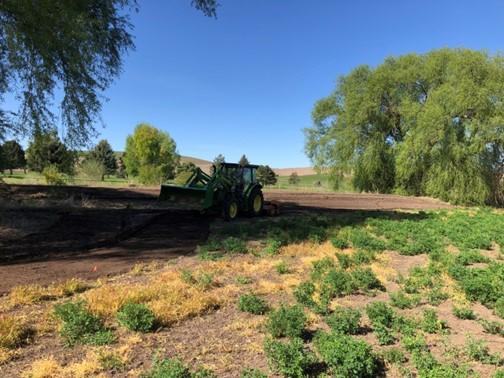

Invasive Grass Species Test Plots: This week Wildlife Area Manager Finch and Spokane District Wildlife Biologist Lowe spent a day mixing up five different post emergence herbicides to apply to the three different test plots. Botanist Emerich completed her line intersect data collection last week identifying all the species in each of the plots preapplication. Emerich will come back again in July to do a post-application line intersect data collection.

Hartsock Unit Floodplain: Wildlife Area Manager Dingman took her all-terrain vehicle out the ridge between Hartsock Grade and the Tucannon to take photos of the changes that are occurring in the Hartsock Unit floodplain. The Quonset and bunkhouse were removed in 2012, the Confederated Tribes of the Umatilla Indian Reservation completed a large wood restoration project in 2017, and the Tucannon River is slowly reclaiming the floodplain.


Providing Education and Outreach
Cattlemen’s Meeting: Wildlife Conflict Specialist Kolb and Wolf Biologist Spence attended the Columbia County Cattlemen’s Association meeting and provided an update on wolves. Wolf Biologist Spence gave a presentation on the Annual Wolf Report and Kolb talked about cost-share programs available to producers to off-set the cost of implementing non-lethal deterrents.
Lakeside High School Field Day: Natural Resources Technician Nizer, Private Lands Biologist Gaston, and Natural Resources Technician Rumiser attended the field day for Lakeside High School hosted at the Spokane Hatchery. Nizer and Rumiser setup and demonstrated the Truax no-till drill and had the students assist with learning how to calibrate the machine. Gaston and Nizer setup a line transect for field identification of plant species the students had to walk and identify.
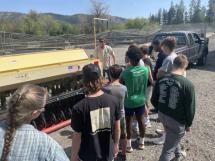

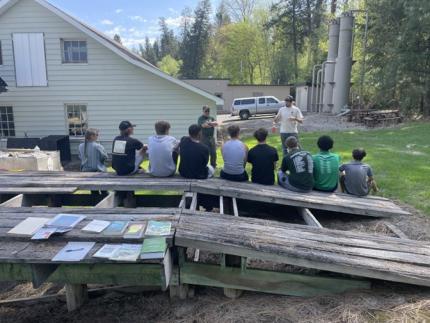
Lecture and Lab: Wildlife Conflict Specialist Kolb, Assistant District Biologist Vekasy and Scientific Technician Moberg conducted a chronic wasting disease lecture and lab with students at Touchet High School.
Conducting Business Operations and Policy
General Facilities and Equipment Maintenance and Repairs: Sherman Creek Wildlife Area Assistant Manager Palmer, Natural Resources Technician Zueger, and Wildlife Area Manager Anderson inspected the irrigation diversion box, settling box, and fish screen at Sherman Creek. Palmer and Zueger had worked earlier in in the week to remove silt and debris from the side channel diversion. As high as the creek was running, it was running even higher the previous week, with the sound of boulders bumping downstream clearly audible. The creek is expected to rise again in the upcoming week as heat keeps melting mountain snow.